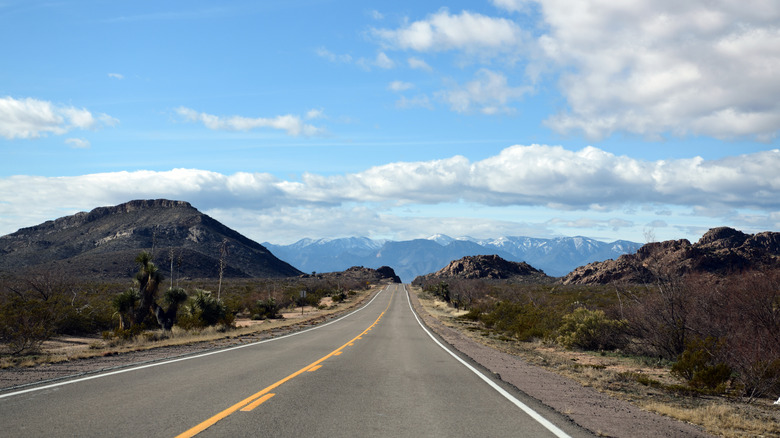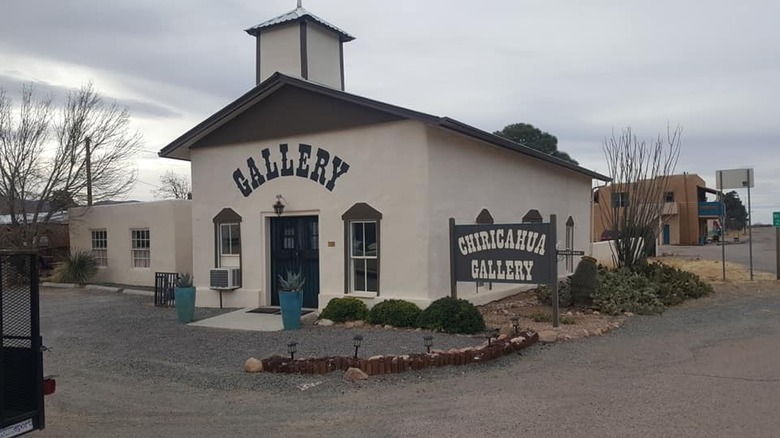'New Mexico's Most Western Town' Is An Artsy Hub With Railroad History And Sweeping Natural Beauty
Steeped in Spanish vaquero traditions and a long history of ranching, many cities in New Mexico could be considered the best "cowboy core" vacation destinations in the American West. But none exude the true Wild West spirit quite like the tiny hamlet of Rodeo. And with a name like that, it's not hard to see why.
Home to only about 100 residents, Rodeo holds the distinction of being New Mexico's "most western town" — a reference to its spot on the map. Draped right along the Arizona border in the southwestern corner of the state, Rodeo straddles State Road 80 in the San Simon Valley near the otherworldly cliffs of the Chiricahua Mountains. It's the perfect pit stop for an unforgettable road trip through Tucson, which is less than an hour's drive away and has one of the nearest international airports. You can find a few cozy places to stay in town, including the Mountain Valley Lodge (snag the Cowboy Room!) and the Chiricahua Mountain Lodge.
Rodeo's roots stretch back to the early 1900s. The desert outpost was established along the El Paso and Southwestern Railroad, an old line that served the copper mining industry of its time across the region. Rodeo draws its name from the Spanish word "rodear," which means "to surround" or "to go around." A once bustling cattle shipping hub, the town's lassoing days are all but bygone. Today, Rodeo stands out for its burgeoning arts scene, and of course, its vast natural beauty.
Saddle up to Rodeo's arts hub
A lively arts community isn't likely what you'd expect to find in a place like Rodeo, where storefronts and historic structures provide a snapshot of the Old West. But, as one visitor to Rodeo puts it on Tripadvisor, "Art always finds a way in the [Southwest], I guess. It's like nature."
You can see the creative labors of love from local and regional artisans with a tour of the Chiricahua Gallery, which is open on Fridays and Saturdays. Desert-inspired paintings, handcrafted woodwork, metal sculptures, ceramic pieces, and other types of art line the shelves and walls of this designated New Mexico Historic and Cultural Site, which is housed in a nearly frozen-in-time adobe building that was built back in 1910.
To see more local artwork, saddle up and venture a couple of miles up the road to the Chiricahua Desert Museum. The facility, which is open daily from 9 a.m. to 5 p.m., boasts an art gallery and gift shop where you can purchase mementos of your time in the great Southwest. You better be a fan of critters that slither, though, because the museum's real pride and joy is its extensive live reptile collection. The exhibit features more than 50 different reptile species, including rare and endangered creatures endemic to the area, as well as lizards and snakes hailing from Mexico. Stroll through the museum's botanical garden to see more local wildlife, including a variety of native birds.
Explore the wilds of Rodeo and beyond
Natural beauty abounds in Rodeo, where the doors to the great outdoors are always open. Well, just about. If you happen to come across the Gray Peak Wilderness Study Area during your travels, which lies just on the outskirts of town, you may be tempted to roam about the lands. Unfortunately, the wildlife refuge currently doesn't offer public access, but you can still marvel at the mountainous backdrop from a distance. You'll also have many other opportunities to explore the surrounding wilderness, which is sprinkled with scenic spots and panoramic vistas.
If you drive about 45 minutes north to the city of Lordsburg, you can tour the Shakespeare Ghost Town, where the likes of notorious gunslinger Billy the Kid and Old West outlaw Johnny Ringo once trod. The old gold-mining community offers daily tours at 10 a.m., 12 p.m., and 3 p.m., depending on tour guide availability, so it's best to call ahead and reserve your visit in advance.
If you cross state lines into Arizona, you can enjoy an afternoon of birding at Willow Tank, located just off of Sulphur Canyon Road in the unincorporated community of Portal. The private wildlife sanctuary features a small pond, which you can walk around to catch sight of killdeer, white-winged doves, and great blue herons, along with over 200 other types of birds. The Chiricahua National Monument, Arizona's "Wonderland of Rocks" full of scenic hiking trails and stargazing sites, is also within driving distance of Rodeo.


